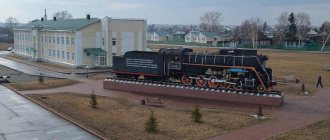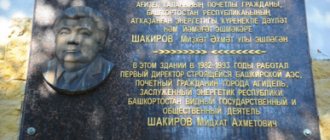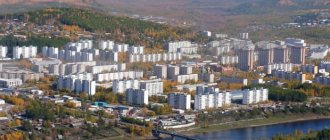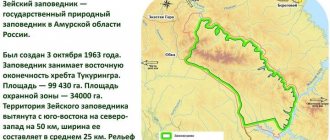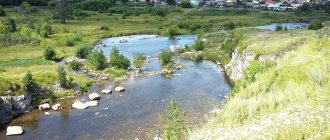- Reports and messages
- Miscellaneous
- Khimki city
One of Moscow's largest urban allies is the city of Khimki.
Its geographical location is on the banks of the Moscow Canal. Beginning of urban formation: November 13, 1851. In the same year, a railway station was opened, and a village was formed with it. By 1869, there were only 39 permanent residents in Khimki. After 40 years, 47 residential yards were registered at the Khimki station. In 1928, the first school was formed under the leadership of Vladimir Mikhailovich Bolotov. From this moment the industry begins to gradually develop. In the same year, a knitting artel was opened, later converted into a factory for the development of knitted products. Population growth began to increase. Due to current circumstances, new buildings with streets began to appear. A little later, villages were formed. Officially documented and renamed from the village to the city of Khimki in 1939.
In the post-Soviet period, a number of events occurred related to the unification of settlements and the preservation of the Khimki forest. The most striking event was on July 28, 2010, when the city hall of Khimki was attacked. The issue of connecting Khimki with the capital of Russia is currently being discussed.
Coat of arms and flag of the city of Khimki. The background of the shield is black and gold. A mythical centaur is depicted holding a bow in his hand. Stars sparkle with bright light all around. The author of the coat of arms is Alexander Mustafin. The colors of the flag and the image are exactly the same as on the flag. Only the space is divided into 2 parts. The right part of the flag has a black color and the design itself, the second part is golden without paintings. The meaning of the centaur is human intelligence and the power of natural resources. The black color on the field is important in the study of the coat of arms - space and is simply an addition to the contents of the flag. The golden hue symbolizes intelligence, objectivity and at the same time heavenly greatness.
Option No. 2
Khimki is a beautiful city located in the Moscow region with its own great and interesting history.
Geography and history
In Russia, on the territory of the Moscow region in 1939, the city of Khimki was formed. In the 1950s Khimki was one of the most important centers of the space and rocket industries, due to the fact that the main defense enterprises were located in the city. The city is located on the banks of the Moscow canal, borders the MKAD (Moscow Ring Road) in the north-west of the capital, and in the north-east it reaches such districts of Moscow as Kurkino and Molzhaninovsky. The following rivers flow through Khimki: Khimka, from which the city got its name, Klyazma, Skhodnya, Goretovka. In addition to rivers, there are reservoirs: Khimkinskoye and Klyazminskoye.
Population
At the time of its inception, the population of the city in 2022 is about 255 thousand people.
Cultural centers and educational institutions
There are many cultural centers in the city, such as: houses of culture and children's creativity, Khimki Drama Theater “Our House”, cinema, museums. Among the educational institutions: schools, technical colleges, colleges, higher education institutions, many libraries, as well as the central children's art school. Among other things, quite a large number of monuments dedicated to the residents of Khimki, who defended their native land during the Great Patriotic War, have been preserved. There are also many parks, squares and sports facilities.
Attractions
The most popular attraction in the city is the Khimki Art Gallery. S.N. Gorshin, which was founded in 1993, thanks to S.N. donated to the city. Gorshin's private collection of paintings from the early 19th and late 20th centuries. The gallery also has almost 500 rare books and about 11 thousand postcards depicting copies of works by Russian and foreign artists. In 1966, famous Soviet architects A. Mikhe, I.P. Ermishin, A.A. Agafonov erected a monument to the defenders of Moscow called “Hedgehogs”. The main meaning of the name is that the monument is a structure made of barbed wire and rails. These structures created barriers to enemy tanks, helping our soldiers in the fight during the war. In addition to the above, the city has a sufficient number of various attractions in the form of temples, parks, monuments and theaters.
Origin of the river's name
Let's start our story with history. The once full-flowing Khimka River was the most important waterway. It flowed along several villages (Gnilushi, Aleshkino, Zakharkovo, Ivankovo), forming a rather deep ravine, and overlooked the Moscow River. We find mention of it for the first time in scribe books dating back to the end of the 16th century. It is curious that in these sources the river was called differently: Khilka, Khinka, Vykhodnya... According to archival records, in the 19th century there were a lot of fish in the river - pike, perch, roach.
Over time, Moscow grew, and Khimka became shallow. At the beginning of the twentieth century, the opposite edges of the river ravine were connected by a railway track. The river itself in this place was enclosed in a concrete pipe. In 1933, construction began on the Moscow Canal, part of which ran along the natural bed of Khimki.
As for the name of the river and the city of the same name, there are several versions of its origin. Perhaps it is associated with the dialect word “hin”, which means “nonsense, trifle, nonsense.” That is, it was implied that Khimka is an insignificant, trifling river. Over time, the essence of this word was lost, and later it was rethought in connection with the active use of the term “chemistry”. There is another hypothesis that connects the hydronym “Khimka” with the Baltic word himinas - “moss”.
Popular message topics
- The work of Tvardovsky
Tvardovsky Alexander Trifonovich (1910 - 1971) is one of the most published poets in the USSR. For many years he was the editor-in-chief of Novy Mir. - Cats Cats
are graceful and very beautiful. Animals have sharp claws, which help them climb trees with ease, and also jump deftly. The body of cats is mainly covered with hair, but there are also species of cats without hair. They have a long tail and ears. - The city of Murmansk
Murmansk is located in North-Eastern Europe and is the largest city in the polar region by population. The city was founded in 1916, and until 1917 it bore the name Romanov-on-Murman.
Khimka River: from source to mouth
Khimka is one of the small rivers of Moscow. Its total length is 18 kilometers, and its catchment area is 40 square meters. km. The watercourse belongs to the Volga basin, being a third-order tributary of the great Russian river.
Where does the Khimka River begin? In Khimki! And this is quite logical and obvious. The source of the river is located on the outskirts of the Khimki forest, two hundred meters from the M-11 expressway. Further, Khimka flows in a southerly direction along Vashutinskoye Highway, passing the low-rise residential complex "Mishino". Then it runs along the northern border of the city of Khimki, goes around the Lesnoy Ugolok residential complex with brightly painted houses and connects with the bed of the Moscow Canal.
For nine kilometers from the city of Khimki to the capital’s Pokrovskoye-Streshnevo district, the river was transformed into a reservoir, which was filled back in the late 30s. In addition to Khimki itself, its bowl also includes Volga water, which enters through the above-mentioned canal.
Where does the Khimka River flow? The watercourse crosses the Volokolamsk Highway and flows into the Moscow River (see map below). Moreover, this place is located only fifty meters from the mouth of the Moscow Canal.
Ecological state of the river
The Khimka River today is not in the best condition. Its valley is actively polluted by oil products and construction waste; harmful substances enter the watercourse from the capital’s oversaturated highways.
Residents of areas adjacent to the river have repeatedly contacted various city authorities regarding the unsatisfactory environmental condition of Khimki. So, for example, at the mouth of the river on 8 Marta Street, 2a, in the spring of 2022, a spontaneous dump of used car tires was formed.
In the area of the Pokrovskoye-Streshnevo park, Khimka is a natural monument of local importance (since 1991) and is protected by the state. Here its valley is most landscaped. If you are lucky, on the banks of Khimki within the park you can meet a muskrat or a beaver.
Underground Khimka
Approximately 10% of the river's total length is underground. Khimka has three underground sections in its lower reaches. One of them is a siphon under the Moscow-Volga Canal. In other words, in this case one river flows under another.
Underground, Khimka flows in two parallel concrete portals. Here it is quite shallow, but wide. In the underground channel there is a branch for the cable collector, which is also partially flooded with river waters. Along one of the portals of Khimki there is an iron bridge half a meter wide, which is used by MosCollector employees.
Where to go with children in Khimki
Young travelers will not be bored in Khimki. There is everything here for your child to have a great rest and gain impressions.
Dinosaur Park "Secrets of the World"
- Opening hours: daily, from 11:00 to 20:00.
- Ticket price: adult from 250 rub. up to 350 rub., children from 150 rub. up to 250 rub.
- Telephone.
- Website: https://www.facebook.com/tainymira
- Address: PKiO named after L.N. Tolstoy. Transport stop "Khimki Station".
How did dinosaurs appear on earth? What did they eat? How did they coexist with other representatives of prehistoric fauna? Visitors to the recreational activities in the popular Khimki Park will get answers to these and many other questions. The island of the green zone is “populated” by the kings of nature of the Jurassic period. Models of giant reptiles emit a menacing growl, blink, breathe, and perform various movements. Lizards are full of life and look very realistic. The excursion includes an educational lecture about the habits, lifestyle, and reasons for the extinction of dinosaurs. At a special site, young visitors will be able to feel like real paleontologists, participating in the reconstruction of excavations of the “burials” of prehistoric animals.
Sheremetyevo Airport Museum
- Opening hours: on weekdays, from 9:00 to 18:00, on Thursdays from 9:00 to 15:30.
- Ticket price: admission is free.
- Telephone.
- Website: https://www.svo.aero/ru/services/in-airport/sheremetyevo-museum
- Address: terminal F of Sheremetyevo airport. Transport stop "Terminal F".
Having made a short trip through the picturesque Khimki forest, which received powerful PR several years ago, adults and young guests of the city will be able to visit an interesting museum. Its exhibition is located on the 5th floor of Terminal F of Sheremetyevo Airport. In the standard half hour allotted for the excursion, you can learn a lot of interesting things here. The guide will talk about how the airport was built and introduce visitors to the collection of aviation instruments previously used in air navigation and aviation meteorology. The boys will probably be interested in the three-dimensional model of the airport terminal, runways, and Sheremetyevo hangars. The reconstruction includes smaller copies of airfield equipment. A retrospective exhibition of airport staff uniforms also attracts the attention of tourists.
Museum-workshop "Attic"
- Opening hours: daily, except Mondays, from 11:00 to 17:00. Lunch break from 13:00 to 14:00.
- Ticket price: from 100 rub.
- Telephone.
- Website: https://vk.com/club133855523
- Address: st. Kudryavtseva, 3. Transport stop “Victory Street”.
A child will have the most vivid memories from visiting this amazing place. Here, ordinary household items that were used by the grandparents of the current guests of the workshop, ancient dolls, toys, and amulets, find a second life. At the same time, all exhibits can not only be viewed, but also held in your hands. The institution has created a unique atmosphere that awakens in children the desire to create, to create something special with their own hands. The necessary skills are instilled in children at master classes in folk crafts, which have been widespread in Rus' since ancient times. And it’s also a lot of fun in a museum created through the efforts of enthusiasts.
Don't miss the attractions:
- Klin, Naro-Fominsk, Odintsovo, Domodedovo, Vereya,
- Dmitrov, Chekhov, Volokolamsk, Lyubertsy, Stupino, Dolgoprudny,
- Balashikha, Sergiev Posad, Noginsk, Ramensky, Reutov,
- Zelenograd, Yegoryevsk, Zhukovsky,
- Voskresensk, Pushkino, Taldom,
- Shchelkovo, Krasnogorsk, Serpukhov, Bronnitsy, Lobnya,
- Zaraysk, Korolev, Elektrostal, Podolsk and Kolomna.
Visiting interesting places in Khimki sometimes becomes part of the excursion program of vacationers who come to admire the historical, architectural, and cultural monuments of Moscow . At the same time, the city is self-sufficient. You can try to explore the main attractions of Khimki in one day or spend a whole weekend here, staying in a comfortable hotel.
